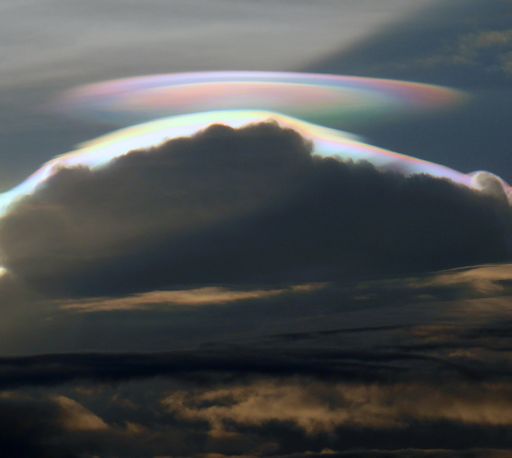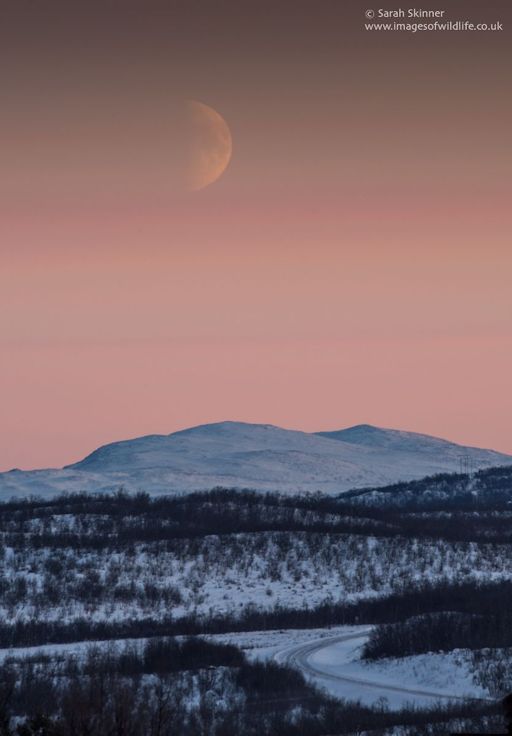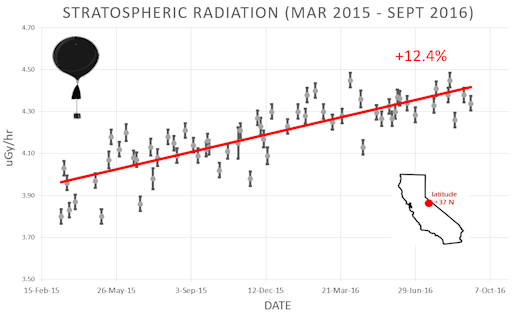Marianne's Arctic Xpress wishes you a Happy New Year. Learn to photograph auroras with the experts. Full photography tuition, all clothing, and semi-pro camera equipment included. Groups of 2 to 8 welcome. Book Now | | | THE SOLAR WIND ... IT'S STILL BLOWING: For the fifth day in a row, a fast-moving stream of solar wind is blowing around Earth. Inside the Arctic Circle, isolated geomagnetic storms are producing occasional bright auroras: photo gallery. Earth should begin to exit the stream on Jan. 10th. Free: Aurora Alerts PILEUS CLOUDS: On Jan. 6th, Peter Lowenstein observed a rainbow-colored saucer over Mutare, Zimbabwe--but it wasn't a UFO. "This is a classic example of a pileus cloud," he says. 
Pileus clouds form on sunny afternoons when the heat of the summer sun causes cumulus clouds to boil upwards. Roiling toward the sky, cumulus clouds push layers of moist air above them where they cool and condense to form droplet-rich cloud caps or 'pileus' (Latin for cap). Sometimes, as in Mutare on Jan. 6th, pileus clouds form very quickly. In such cases their water droplets tend to be all the same size--the perfect condition for iridescent colors.
Lowenstein took four pictures over a period of just three minutes. "They show the cloud appearing, then changing shape and color," he says. "One minute later it had disappeared behind the summit of the growing cumulonimbus cloud." Realtime Space Weather Photo Gallery ARCTIC COLORS: When people think of "Arctic colors," they usually visualize green, the heavenly hue of Northern Lights. But that's only one dab on the palette of polar chromatography. While auroras paint the night sky, twilight rays of exquisite beauty rule the day. On Jan. 5th, photographer Sarah Skinner captured the latter in this photo she took from Abisko National Park located 250 km inside the Arctic Circle: 
"It was approaching midday yesterday when I looked out of the window and noticed the most incredibly beautiful pink sky," says Skinner. "Linear clouds adorned the sky as the Moon was beginning to rise, looming over the frozen landscape." In Abisko, the sun never rises at this time of year, but it does approach the horizon from below. Twilight colors spill over the landscape for hours at a time, creating scenes of enduring loveliness that cannot be found at lower latitudes. "The striking pink hue stayed in the sky for quite some time, providing ample opportunity to capture some lovely images," adds Skinner. "Such colours and subtle lighting at this time of the year makes the Arctic region such a fabulous destination for photography." More of Sarah's images may be found on her web page, Andy and Sara Skinner Wildlife & Nature Photography. Realtime Aurora Photo Gallery
Realtime Airglow Photo Gallery
Realtime Sprite Photo Gallery Every night, a network of NASA all-sky cameras scans the skies above the United States for meteoritic fireballs. Automated software maintained by NASA's Meteoroid Environment Office calculates their orbits, velocity, penetration depth in Earth's atmosphere and many other characteristics. Daily results are presented here on Spaceweather.com. On Jan. 9, 2017, the network reported 6 fireballs.
(5 sporadics, 1 Quadrantid)  In this diagram of the inner solar system, all of the fireball orbits intersect at a single point--Earth. The orbits are color-coded by velocity, from slow (red) to fast (blue). [Larger image] [movies] Potentially Hazardous Asteroids ( PHAs) are space rocks larger than approximately 100m that can come closer to Earth than 0.05 AU. None of the known PHAs is on a collision course with our planet, although astronomers are finding new ones all the time. On January 9, 2017 there were 1758 potentially hazardous asteroids. Notes: LD means "Lunar Distance." 1 LD = 384,401 km, the distance between Earth and the Moon. 1 LD also equals 0.00256 AU. MAG is the visual magnitude of the asteroid on the date of closest approach. | | Cosmic Rays in the Atmosphere |
Readers, thank you for your patience while we continue to develop this new section of Spaceweather.com. We've been working to streamline our data reduction, allowing us to post results from balloon flights much more rapidly, and we have developed a new data product, shown here: 
This plot displays radiation measurements not only in the stratosphere, but also at aviation altitudes. Dose rates are expessed as multiples of sea level. For instance, we see that boarding a plane that flies at 25,000 feet exposes passengers to dose rates ~10x higher than sea level. At 40,000 feet, the multiplier is closer to 50x. These measurements are made by our usual cosmic ray payload as it passes through aviation altitudes en route to the stratosphere over California. What is this all about? Approximately once a week, Spaceweather.com and the students of Earth to Sky Calculus fly space weather balloons to the stratosphere over California. These balloons are equipped with radiation sensors that detect cosmic rays, a surprisingly "down to Earth" form of space weather. Cosmic rays can seed clouds, trigger lightning, and penetrate commercial airplanes. Furthermore, there are studies ( #1, #2, #3, #4) linking cosmic rays with cardiac arrhythmias and sudden cardiac death in the general population. Our latest measurements show that cosmic rays are intensifying, with an increase of more than 12% since 2015: 
Why are cosmic rays intensifying? The main reason is the sun. Solar storm clouds such as coronal mass ejections (CMEs) sweep aside cosmic rays when they pass by Earth. During Solar Maximum, CMEs are abundant and cosmic rays are held at bay. Now, however, the solar cycle is swinging toward Solar Minimum, allowing cosmic rays to return. Another reason could be the weakening of Earth's magnetic field, which helps protect us from deep-space radiation. The radiation sensors onboard our helium balloons detect X-rays and gamma-rays in the energy range 10 keV to 20 MeV. These energies span the range of medical X-ray machines and airport security scanners. The data points in the graph above correspond to the peak of the Reneger-Pfotzer maximum, which lies about 67,000 feet above central California. When cosmic rays crash into Earth's atmosphere, they produce a spray of secondary particles that is most intense at the entrance to the stratosphere. Physicists Eric Reneger and Georg Pfotzer discovered the maximum using balloons in the 1930s and it is what we are measuring today. | | The official U.S. government space weather bureau | | | The first place to look for information about sundogs, pillars, rainbows and related phenomena. | | | Researchers call it a "Hubble for the sun." SDO is the most advanced solar observatory ever. | | | 3D views of the sun from NASA's Solar and Terrestrial Relations Observatory | | | Realtime and archival images of the Sun from SOHO. | | | from the NOAA Space Environment Center | | | a proud supporter of science education and Spaceweather.com | | | the underlying science of space weather |  | Beautyz for top beauty products reviews and their buying guides | | | These links help Spaceweather.com stay online. Thank you to our supporters! | | 
